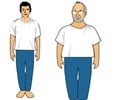People who live near high density fast food outlets and who frequently eat at those restaurants are more likely to report an increase of 3 pounds in weight and .8 inches in waist.
On the other hand, the research led by Oregon Research Institute (ORI) scientist Fuzhong Li, Ph.D., also found that high-walkability neighborhoods were linked with a decrease of 2.7 pounds in weight and 0.6 inches in waist size among residents who increased their levels of vigorous physical activity during a year."This is one of the few longitudinal studies that focus on change in individuals' body weight over time in relation to their lifestyle behaviors and immediate living environments," said Li.
He added: "The uniqueness of this study lies in its environment-person approach which we use to show that health-impeding environments, such as a high density of fast-food outlets, together with residents' behavior, such as eating fast food regularly, can have an unhealthy impact on body weight. On the other hand, health-promoting environments, such as walkable neighborhood streets, in conjunction with physically active residents, can have a positive impact on body weight over time."
The study is part of the Portland Oregon Neighborhood Environment and Health Study where researchers are following a sample of over 1200 local residents ages 50-75 years old over a three-year period.
And they are using anthropometric and survey measures, such as body weight, height, eating habits, food intake, physical activity, and perceptions of their immediate neighborhood environment.
Also, the scientists have taken objective measures of built environment characteristics, such as land-use mix, density of fast-food outlets, street connectivity, and public transit stations, and the presence of green and open spaces in 120 randomly selected neighborhoods in Portland, Oregon.
Advertisement
"To combat the obesity/overweight problem, it appears clear that, from the perspectives of public health and urban design, efforts are needed to improve features of modifiable built environments by making them more conducive to healthy eating and increasing physical activity," said Li.
Advertisement
Source-ANI
ARU/L









